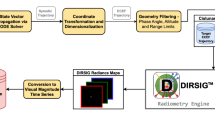Abstract
A theoretical analysis of the potential accuracy of early modern planetary models employing compound circles suggests that fairly simple extensions of those models can be sufficiently accurate to meet the demands of Tycho Brahe's observations in both ecliptic longitude and latitude. Some of these extensions, such as the substitution of the true sun for the mean sun, had already been taken by Kepler before he abandoned circular models. Other extensions, involving one or two extra epicycles, were well within the mathematical capabilities of sixteenth-century and seventeenth-century astronomers. Hence neither the failure of astronomers before Kepler to correct errors in planetary positions nor Kepler's decision to abandon circular models was a consequence of inherent limitations in those models.
Similar content being viewed by others
Author information
Authors and Affiliations
Additional information
Communicated by C. A. Wilson
Rights and permissions
About this article
Cite this article
Gearhart, C.A. Epicycles, eccentrics, and ellipses: The predictive capabilities of Copernican planetary models. Arch. Hist. Exact Sci. 32, 207–222 (1985). https://doi.org/10.1007/BF00348449
Received:
Issue Date:
DOI: https://doi.org/10.1007/BF00348449




